Intro to EF Suspension Tuning By Ben Ogle
UCA = Upper control arm
LCA = Lower control arm
Shock = Damper
Camber curve ~ Amount camber change throughout the compression of the suspension.
CG - center of gravity
First off, I would like to say that this will not contain everything. I am not all knowing and I am not writing a book. There are some books on suspension tuning, however, that you should buy and read. A couple of them are: "How to Make Your Car Handle" by Fred Puhn and "Tune To Win" by Carroll Smith. These books, while not targeted at FWD, are invaluable.
Suspension tuning is mostly about getting the most from your tires. The tires should stay planted squarely on the ground all the time. Unfortunately, this is impossible because of the suspension itself, which we need so we can absorb the bumps that are everywhere. If there were no bumps then we would have no need for suspension, and the tires would be always putting their full contact patch down. But since we need the suspension, some compromises will have to be made and we wont get all 4 full contact patches down all at once.
Suspension tuning is also partly about making the car easy for the driver to drive fast. This depends on your goals for the car but generally, a car that sticks but is impossible to drive is pretty useless. We want there to be a little room for human error (especially for us Honda owners, cause not many of us are professional and error free drivers) so the car is predictable and builds confidence in the driver.
This brings us to our goals. No matter what you are going to be doing with the car you want to make the fucker stick and make it easy to drive.
The Suspension:
We are lucky enough to have an unequal length double wishbone suspension on the front and rear of our EFs (and all other 88-00 civics and 90-01 integras). It consists of, basically, an arm on the bottom connecting the bottom of the chassis to the bottom of the steering knuckle, and a shorter arm on top, connecting the top of the knuckle to some portion of the chassis above the lower control arm mount. This type of suspension is regarded as the best type of suspension to have for racing (not drag racing) because of the camber gain characteristics. If you've ever lowered a Honda, you know that the lower it goes the more negative camber there is. Its like that for a reason.
Why is camber gain good? Because when you take a corner your car rolls and the outside suspension is compressed. When your car rolls the UCA mount is shifted toward the outside of the turn and the LCA mount is shifted a little toward the inside. This pushes the top part of the tire to the outside of the turn and the bottom part inward. When that happens, you end up with a positive camber situation for the outside tires (which do most of the work), and positive camber means you aren't using the tire's whole contact patch. Quite obviously, when you aren't using the whole contact patch you get less grip. The idea of camber gain is to keep the outside tires at 0 camber during roll.
How does it work? A shorter arm pivots around a smaller circle than a large arm. That means that, for the same vertical displacement of both arms, a shorter arm will move inward more than a longer arm. So, when the suspension compresses, the shorter (top) arm will move inward more than the longer (bottom) arm and the top of the knuckle will be pulled inward. The pull of both arms grows exponentially as the angle increases (up, away from being horizontal) because the arm is pivoting around a circular path, but the shorter arm's pull will grow faster. This inward pull of the top arm is cancelled out by the UCA mount moving in to the outside, and ideally your camber wouldn't change throughout the whole turn.
EF Strengths:
Aside from the suspension design the EF chassis has a few other things on its side.
1 Cost.
You can get a niceish EF with minimal problems and a clean title for under $2000. If you don't care about pretty ones they can be had for under $1k. Mine was $800 and it has a little rust. So what?
2 Weight.
Light EF's are easy to find. If you want a light one try and find the oldest and lowest model you can in the body style you want. Weights for most Hondas are here.
3 Ease of upgrading.
88-91 civics are, and have been, abundant and pretty popular so the aftermarket support is large. They are also not the most popular Hondas so the parts aren't all that expensive. EFs share many designs with their heavier/more popular siblings (EG civic, DA integra, and DC integra) so quite a few upgrades can be had just from swapping other Honda parts on to your car. That is covered here.
EF Problems:
So now that you know that your civic and its suspension is a good base and, for the most part, why, we should discuss the problems we should to attempt to fix on the EF chassis.
1 All the camber change stuff doesn't really matter if it isn't engineered right. If the camber curve isn't aggressive enough then you will still end up with positive camber during roll. Our EFs suffer from this and must have the roll reduced and the camber curve made more aggressive.
2 In stock form, our EFs understeer like a bastard. That needs to be fixed.
3 In stock form, the EF chassis feels pretty sloppy and turns in slow-like.
Solutions:
Lowering - Lowering helps all kinds of stuff. First off your car is lower. That means your CG height is lower than it was before. When your CG height is lowered less weight is transferred laterally. This means that less weight is moved off your inside tires and onto your outside tires. In doing that you are allowing the outside tires to not be as overworked, and you are giving the inside tires more of a job to do. Lowering is one of the few ways to reduce overall lateral load transfer the other ways are illustrated in the equation:
Lateral load transfer (lb) = (Lateral acceleration (g) x car weight (lb) x CG Height (in))/track width(in)
Lowering also makes our UCA sit at more of an extreme angle than before. This makes the camber curve for a lowered Honda more aggressive than a non-lowered version of the same car.
So after reading the last paragraph you are thinking, "why doesn't everyone just dump their car to the ground?" Because of travel. If you go too low something will bottom out. With stock shock travel it is the shocks first. Travel on the shocks can be increased fairly easily. If you have more shock travel than stock and you go too low your front (don't know about the back) UCA's will bottom on your inner fenders. That type of bottoming is violent, hard on shit, and it makes the car very unpredictable.
Stiffening your springs - Lowering your car is going to give you less travel than you had to begin with. You don't want to bottom anything out so you probably should look into increasing your spring rates. This not only helps with keeping you off the bumpstops, it also reduces roll, and makes the turn in quicker. Yay!
Fortunately many of the companies who sell lowering springs or coilovers think of this and so most aftermarket springs are stiffer than stock. But just because the rates are stiffer doesn't mean they are good. Companies don't want to sell you a product that will make your car harder to drive (like by giving you oversteer) because it is a liability. So the spring rates in those lowering spring and coilover kits tend to make your car still understeer. Shitty, eh?
Before we talk about that, though, I think we should touch on something that is needed with stiffer springs.
Shocks - Shocks, struts, dampers, whatever control the oscillation of the spring. We've all seen a car with stiff springs and stock shocks - they bounce all over the place and rock back and fourth (something the local, and probably beyond, VW guys have named the "Honda bounce." Haha, funny funny.). This bouncing is caused by the oscillation of the springs. When the car hits a bump it compresses the spring (that's why they're there) and when the spring compresses it stores energy. After the bump, the springs energy is then released and, if your shocks work, that energy is then absorbed by the shock. If your shocks suck, the springs energy will extend the spring past its normal length and then store more energy, then release, etc. until your crappy shocks stop the oscillation. Stiffer springs need stiffer shocks because the springs store and release more energy than softer springs.
The best regular, off the shelf shock for our Hondas is the Koni sport (yellow). They are stiff, adjustable, rebuildable and if you got money, they can be shortened and revalved by Koni. With the OTS Konis people don't generally like to go over a 500lb/in spring. There are more factors that determine what the highest spring rate for a shock is but I'm not going to go over them.
There are other adjustable shocks out there like the KYB AGX's - which I have personally had and found that they are MUCH softer than my yellows - and Tokico illuminas - which I know nothing about. Neither of these shocks are rebuildable. Which shocks you get really depend on your budget and what you are doing with the car; ie if your car is a street car only, you don't need yellows, and you probably don't need to pay for the illuminas. Also, I feel it is worth noting that my EF yellows were ½" shorter than my EF AGX's I used to have.
Adjusting the shocks is a hit and miss deal. You have to be REALLY in tune with your car and be able to take a series of corners many times. What you gotta do is drive your series of corners a couple of times, adjust, drive again, adjust etc. The car will feel bouncy and will wallow if the shocks are too soft, and if they are too stiff the tires will chatter and skip across the bumps. Shocks also help make the turn in quicker so you can adjust for that too. I have a feeling you really wont get into the "too stiff" territory if you are running really stiff springs, but hey, weirder things have happened.
Back to where we left off before this shock detour.
Choosing the right spring rates - You don't want your car to understeer. The level of non-understeerage is up to you. It depends on your driving experience, preference, and most importantly, your goals for the car. For street cars that are just street cars, many people are fine with the very front stiff rates that come in lowering spring kits. But if you want the car to rotate (not understeer) then you shouldn't be satisfied with lowering springs. "How do I get my car to rotate?" you ask. Increase the rear spring rates or lower the front ones.
"Why does that work?" We have already established that when your car goes around a corner a certain amount of weight is transferred from one side to the other. And we know that that TOTAL lateral weight transfer is independent of the spring rates (and suspension type). What the different spring rates do is change where the majority of that load/weight transfer is happening. If you raise the rear spring rate then a higher percentage of the rear's weight will be transferred between the 2 rear tires (until you lift a tire, then the maximum amount of weight is being transferred). This decreases rear traction slightly and takes strain off the outside front. The strain coming off the outside rear lets the inside front do more work, thus increasing traction up there on there steering end of the car. Increasing the traction up there helps with turning AND it helps put more load on the inside tire so you get more accelerative traction and can put more power down without the use of an LSD.
Typically to get a Honda to handle in a neutral fashion, the car needs to have spring rates with a rear stiff bias. I don't know of any company that makes lowering springs with rear stiff rates. The better option to lowering springs is coilovers (for the ride height adjustment feature too). Most coilovers come with stiff springs that are supposed to go on the front and softer springs for the back. But all four springs are the same length and design (besides rate) so you can just switch them front to back. Instant rear stiff bias, eh? If the rates that come with the coilovers don't grab you the right way, you can buy extra springs in the rates and lengths you want for fairly cheap. The Honda-tech.com road racing forum has a spring swap meet thread where people go to sell their used springs.
When selecting springs just don't go too stiff. You want them stiff, but not so stiff that your tires skip across bumps and stuff. You still want the suspension to be able to absorb bumps and road irregularities so don't go too stiff. A decent, stiffish spring rate setup on an EF is 400lb/500lb (f/r; this also happens to be the rates in the skunk2 and GC integra coilover kits). Its not too stiff and its not too soft. Many people with street cars opt for lower rates and many people who road race like the rates to be higher. I personally think it is a good compromise and a great starting point. These rates in a car with a stock sway bar configuration probably wont make the car as prone to rotate as some people like. There is more tuning that can fix that, though.
Sway bars - Sway bars act just like springs when the car rolls (cause its going around a corner) and act like they aren't even there during the suspension's regular bump compression. This is useful in that you can tune the oversteer, understeer, and roll characteristics without changing the ride. Sway bars also really really help the turn in characteristics of the car.
Since they act just like springs when you are going around a corner they adhere to the same principles; a larger rear sway bar will increase the weight transfer at the back end of the car and therefore increase traction at the business end.
Many people have figured this out and use sway bars as the only form of oversteer/understeer tuning. That's dumb because then people end up with huge rear sway bars. The bigger the rear sway, the less independent your rear suspension will be and the less stable your car will be over bumpy corners (do they make glassy smooth corners? I haven't found any). I have some other theories about bigass rear sways that I am not going to share because they might be wrong (*cough*snapoversteer*cough*). But the bottom line is that you don't need a 22mm rear sway bar on your EF. And if you think do then you have the wrong spring rates.
Bushings - As your suspension gets stiffer the chassis is taking more of the stresses that your suspension used to absorb when it was soft. This translates into more force on your 13-16 year old rubber bushings and therefore more deflection. Bushing deflection is bad. A lot of it can make the car feel sloppy and unpredictable, which is obviously not what we are looking for.
There is really only one practical solution to the deflection and that is aftermarket polyurethane bushings. These are GREAT for radius rod bushings, sway bar bushings, and other bushings that don't need to rotate. In fact, they can make your sway bars behave like a larger, rubber mounted bar and the radius rod bushings can help get rid of that annoying wheel hop.
The rotating bushings, which all the control arms have, are a different story. Many people use them and are fine, but there are some inherent problems with the bushings. See, with your rubber bushings there is no sliding friction. The sleeve that rotates is bonded to the part of the bushing that doesn't rotate. When the sleeve rotates, it rotates because of the deflection of the rubber and there is no sliding friction. Urethane bushings do not do this. Polyurethane is not near as compliant as rubber so the manufacturers have to make the sleeve rotate in the bushing. If the bushings aren't kept lubricated all the time (I don't know about you but I don't want to lube my bushings every other week) they bind. Binding is bad. Binding makes your car unpredictable. The binding can be identified by squeaking and groaning while the suspension moves through its range of travel.
Then there are the trailing arm bushings (big ones that the trailing arm rotates on). This is the worst place to put poly bushings, and the stock TA bushings are usually bad so a lot of people put poly in there. The poly bushings are bad because, once again, polyurethane is not as compliant as rubber and so it cannot move easily in the ways it needs too. Here is a quote (I took without permission, so if scott is reading this let me know if its ok to use) from a very smart guy named Scott (RR98ITR) on Honda tech from this thread:
"In any case the [trailing arm] bushing installation must allow lateral plunge, and rotation about an axis roughly parallel to the centerline of the car, thru the range of motion (there is lateral displacement of the arm, and there IS bump steer, and there's very little you can do about it - therefore if you don't have allowance for plunge and said non-axial rotation, you will have binding forces). The Poly type bushing setups I've seen don't adequately account for this - and you can have problems, in some cases big problems."
The best solution to a cracked or barely there trailing arm bushing is to go with some mugen bushings (cant get OEM because you'd have to buy a whole trailing arm). They aren't terribly expensive and are made from a hard rubber. If you have DA trailing arms you will have to swap the TA's to either the EF or DC units.
Heres a pic of the DC mugen bushing (thanks goes to Colin for the use of the pic):
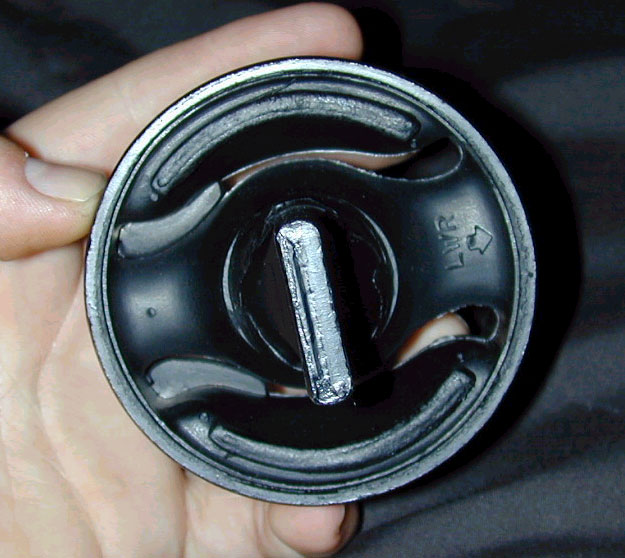
Chassis stiffeners - Once again, as your suspension gets stiffer the stresses on the chassis go up. When this happens your chassis flexes. Chassis flex makes the initial turn in slow and car just generally feel sloppy. Unfortunately our EF chassis isn't all that rigid and with stiff suspension, it flexes a lot. Many people combat chassis flex with strut bars, lower tie bars, etc. The bars, IMO, mainly improve feel. Driving a solid car is much more confidence inspiring than a sloppy one. The bars probably wont decrease lap times but they sure do make the car feel better.
Flimsy bars, however, do nothing. The amount the chassis actually flexes in these regions is small and if the bar can easily flex for those small distances, it will do nothing. So the trick is to find rigid bars, like bars with no pivot points.
Adjustments:
Camber - Camber is the tilt of your tires. Negative camber is when the top of the tire is tilted inward and positive camber is when the top of the tire is tilted outward. Static camber is the camber angle measured when the car is just sitting there. Static negative camber is used by us Honda folks because the camber curves on our cars aren't aggressive enough. The goal is to get the tire to lay down its full contact patch around a corner. Too much static camber in either direction will give you less than optimum traction.
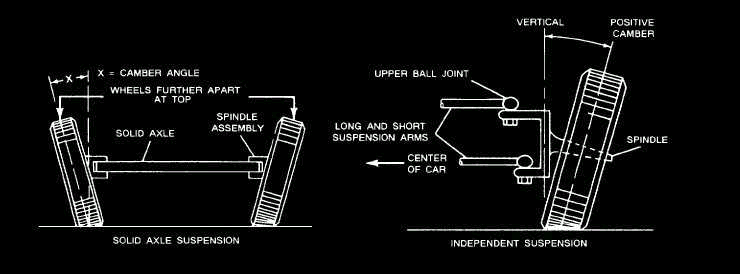
The static negative camber is obviously bad for straight line acceleration if you have a lot of power because you aren't using the whole tire. Oh well. The compromise has to be made.
The camber can be adjusted in the front only if you get camber kits. There are 3 different kinds of camber kits: UCA bushing type, adjustable UCAs, and adjustable ball joints. The UCA bushing type are by far the most popular because they are cheapest. Heres a pic of them:
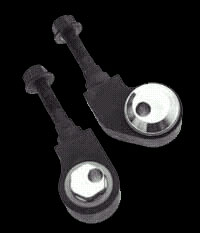
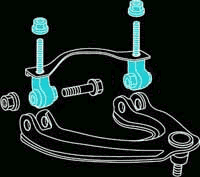
The 2nd type is the adjustable UCA. They have slots so the ball joints can move in and out.
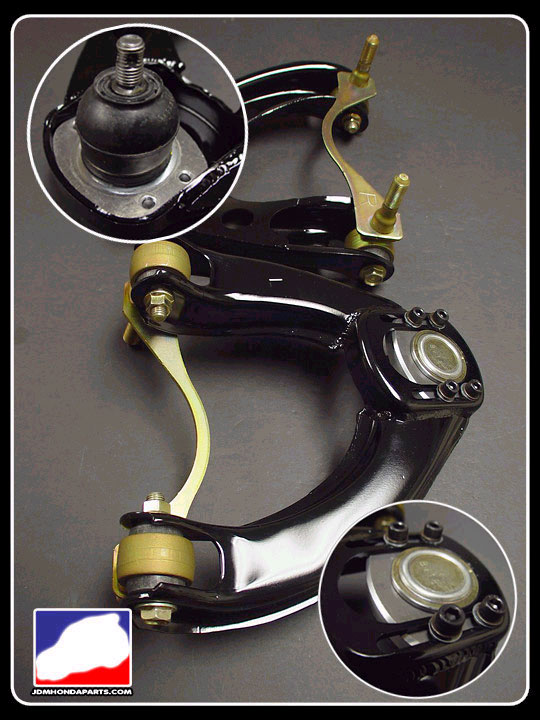
The ball joint type is an eccentric ball joint:
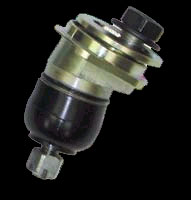
For the rear you can do the washer trick. Just put the amount of washers you want between the UCA mount and the body. If that is too ghetto for you, you can get some adjustable UCA's.
Another note on camber: It does not wear your tires faster than normal. Toe does that.
Toe - Toe is the amount, in inches, that the wheels are either pointing toward or away from each other. Toe in is (drastic toe in anyway) when the wheels look like they are both turning toward each other. Toe out is the opposite. Static toe is the toe set by you or the alignment shop.
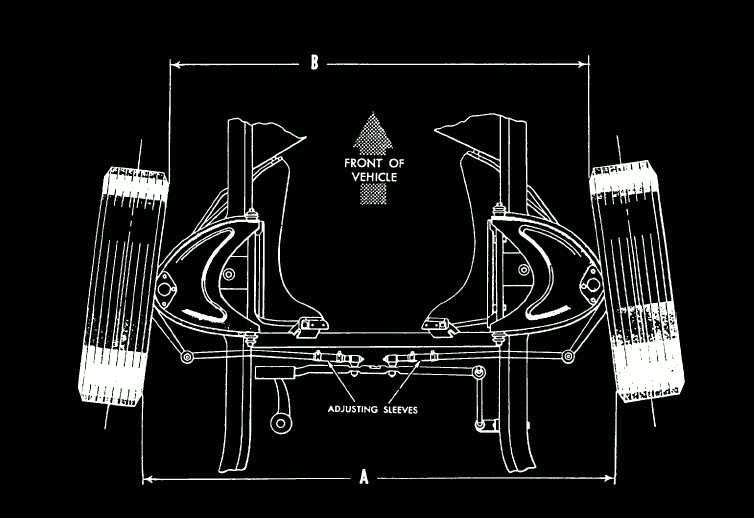
Usually, on a street car, the toe on all 4 wheels is set to 0 because 0 is good for tire wear. But toe can be used to tune the cars turn in characteristics. Front toe-out is usually used on FWD autocross cars (good starting point is 1/16" - 1/8" total toe-out). This helps the quicken the turn in. Too much toe out will make the car feel darty and it will have a lot of bump steer - which is very annoying to say the least. If you toe in the front, the car will feel stable while going straight and it wont turn in well.
Toe-out in the rear also helps the car rotate. But it makes the car really twitchy. Toe-in on the rear, just like the front, makes the car more stable.
Toe is a trial and error adjustment. Just play with it and see what happens.
Caster - Caster is the front-to-back inclination from the bottom ball joint to the top one (think of a bike, the forks are tilted back, that is + caster).
The more positive caster there is, the more camber gain you will have when you turn. Remember our weak camber curves? Yeah, more + caster helps fix that. On our cars, however, the caster is not adjustable.
Weight - Get rid of as much as you can. Lowering the weight of the car reduces lateral weight transfer and according to Carroll Smith in Tune To Win, "Lateral load transfer is a bad thing." The amount of weight you can take off is determined by the rules of your racing organization and/or what you can stand.
The weight distribution on our FWD Hondas is pretty crappy and it usually gets crappier as we take out weight. This is because there isn't really much important in the back of the car. You know, all the trunk stuff goes, then the back seats, etc. Then your car understeers more. I am assuming that this is from there being more weight transfer at the front of the car than the rear, if I am wrong e-mail me. So to try and not make your car understeer more, loose weight off the front (fiberglass hood, ditch anything that doesn't control the engine, etc.) and move crap to the back (like your battery). Simple, eh?
Conclusion:
When tuning your suspension keep in mind that cars that handle well, handle that way because of the little things. Anyone can dump their car and bolt on a huge rear sway but it takes time and effort to really get the car to behave the way you want and do it predictably. You also do not need to spend a whole ton of money to get it to handle, really, minimal parts are needed. All you have to do is spend the time.
This writeup turned out to be way longer than I originally wanted but I hope you learned something.
Home






